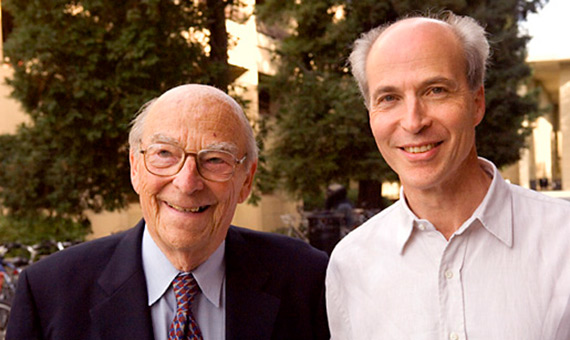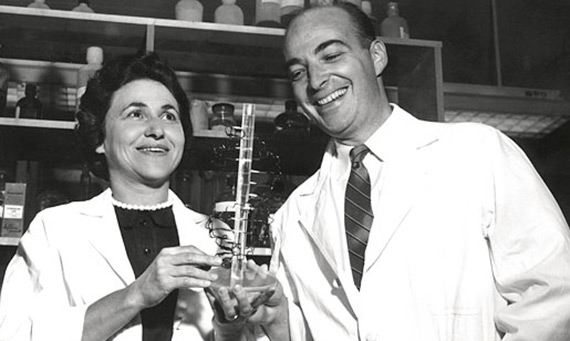A Nobel Prize for Medicine that generated heated debate after its award, but that despite this has had a very positive impact, was that won in 1959 by the Spaniard Severo Ochoa (24 September 1905 – 1 November 1993) and the American Arthur Kornberg (3 March 1918 – 26 October 2007) for their discovery of two enzymes that appeared to be responsible for the biosynthesis of RNA and DNA, respectively
The centennial of the birth of Kornberg, nearly 60 years after the award of the Prize, seems a good time to analyze the winners’ own research and all that came later, and that made their Nobel Prize a very special one.
The Nobel Prize enzymes
Ochoa and Kornberg became interested in the mechanism for synthesizing nucleic acids in the wake of the publication by Watson and Crick in 1953 of the double helix model of DNA, which also suggested how this synthesis could be carried out.
Only a few years later, following some difficult work, Ochoa and Kornberg independently (although Kornberg spent time in Ochoa’s laboratory to learn the techniques for analyzing enzymes and to some extent could be considered his “pupil”) isolated two enzymes that could explain the molecular mechanisms for synthesizing DNA and RNA.
Specifically, from Escherichia coli, a bacterium that is commonly present in the human intestine, Kornberg isolated the DNA polymerase that in vitro and using DNA obtained from a variety of organisms, was able to synthesize new complementary DNA chains by incorporating the 4 deoxyribonucleotides (adenine, thymine, cytosine, guanine) that form part of these molecules.
For his part, Ochoa used another bacterium, Azotobacter vinelandii, to isolate the polynucleotide phosphorylase that was also capable of synthesizing chains of this macromolecule in vitro and using the 4 RNA ribonucleotides (A, C, G and Uracil instead of thymine, suggesting that it could be the enzyme that copied in vivo the information carried by DNA and RNA.
Not everything is what it seems
Shortly after the two were awarded the Nobel Prize a number of observations were made that raised doubts about the role of these two enzymes. In the case of Kornberg’s DNA polymerase, it was discovered that there were bacteria whose gene that controlled this enzyme had mutated, but that nevertheless did not have problems to replicate and live. Given this, a number of research projects were carried out, in which Kornberg’s son Thomas B. Kornberg played a leading role. They demonstrated that Escherichia coli has various different DNA polymerases (as many as 5) that can synthesize and copy DNA. This research concluded that the DNA polymerase discovered by Kornberg (which was called DNA polymerase I), acted in processes of DNA repair and processing in the bacteria. The other, called DNA polymerase III, acted mainly on its synthesis.

Some problems also emerged soon with respect to the enzyme discovered by Ochoa. This was because as well as not needing the DNA template to synthesize the RNA chains, which was not normal in vivo, and not needing the presence of 4 ribonucleotides for the synthesis, it was observed that if the in vitro reaction persisted over time, what the enzyme did was degrade all the RNA chains that had been synthesized previously. In these circumstances, research was carried out that made clear that the synthesis of RNA based on DNA is occurs in vivo by another different enzyme, called RNA polymerase, and that in reality what the enzyme discovered by Ochoa does is degrade the RNA, and in any case, add ribonucelotides specifically at the ends of some RNA chains previously synthesized by polymerase RNA.
The birth of genetic engineering
Although following the award of the Nobel Prize the roles assigned to the two enzymes discovered by Kornberg and Ochoa could not be confirmed, their use was extremely useful in initially clarifying some basic aspects of how living beings function.
Thus, after Kornberg’s in vitro experiments with DNA polymerase it was established how the synthesis of DNA in vivo occurred.
In turn, many experiments carried out by Ochoa and other researchers with his enzyme helped clarify that living beings contain a genetic code of nucleotide triplets by which the information contained in DNA is transferred specifically to the amino acid sequence of proteins; although not directly, but through the synthesis of an RNA that carries the information to the proteins.
Ochoa did not publish a book on his research, but a number have been written about him by other authors, among which are that by Marino Gómez Santos “Severo Ochoa. Biografía Esencial” (Severo Ochoa: Essential Biography), 2005. Fundación Lilly; and by Juan Fueyo “Exilios y Odiseas. La historia secreta de Severo Ochoa” (Exiles and Odysseys: the Secret History of Severo Ochoa), 2017. Editorial Milenio.
The experiments carried out by Ochoa and Kornberg have been considered the cornerstone of genetic engineering, as they demonstrated for the first time that it is possible to synthesize RNA and DNA artificially, and also because their enzymes were among the first to be incorporated into the toolkit of this technology. Kornberg is even considered to be the pioneer of artificial synthesis of life, as some people consider DNA to be the “molecule of life”, and because he was also capable of synthesizing DNA artificially from a virus and demonstrated that it was infective. In fact, when the experiments of the two men were made known, a number of personalities in politics and society, including the then U.S. President L.B. Johnson, gave them nearly the same importance as Clinton and Blair more recently gave to the sequencing of the human genome.

However, ten years after Ochoa and Kornberg’s Nobel Prize, it was awarded to the three researchers Nirenberg, Khorana and Holley, for their contribution in clarifying the genetic code of nucleotide triplets of living beings, without taking into account Severo Ochoa’s contribution through experiments with “his” enzyme. Ochoa was however recognized by Nirenberg in his Nobel lecture: Most of his bibliographic references were to Ochoa’s team!
Kornberg did publish a book on his scientific life: “For the love of enzymes: Odyssey of a Biochemist”, 1989, Harvard University Press; and there is a more recent text by E.C. Friedberg: “Emperor of Enzymes: A biography of Arthur Kornberg , Biochemist and Nobel Laureate”, 2016, World Scientific.
Manuel Ruiz Rejón
Bibliography
- Grunberg-Manago, M.; S. Ochoa. 1955. Enzymatic synthesis and breakdown of polynucleotides: polynucleotide phosphorilase. J. Am. Chem. Soc, 77: 3165-66.
- Kornberg, A. et al. 1956. Enzymic synthesis of deoxiribonucleic acid. Biochem. Biosys Acta. 21: 197-198.
- Kornberg, Th.; Gefter, M.L.1970. DNA synthesis in cell free extracts of a DNA polymerase defective mutant. Biochem. Biophys. Res. Comun. 40: 1348-55.
- Furth, J. et al. 1962. The role of Deoxyribonucleic Acid in Ribonucleic Acid synthesis. I. The purification and properties of Ribonucleic Acid Polymerase. J. Biol. Chem. 237: 2611-19.
- Kwon, D. 2017. Sylvy Kornberg: Biography of a Biochemist. The Scientist, June 13.
Comments on this publication